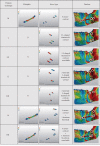Fixation Methods for Mandibular Advancement and Their Effects on Temporomandibular Joint: A Finite Element Analysis Study
- PMID: 32185199
- PMCID: PMC7060428
- DOI: 10.1155/2020/2810763
Fixation Methods for Mandibular Advancement and Their Effects on Temporomandibular Joint: A Finite Element Analysis Study
Abstract
Objectives: Bilateral sagittal split osteotomy (BSSO) is a common surgical procedure to correct dentofacial deformities that involve the mandible. Usually bicortical bone fixation screw or miniplates with monocortical bone fixation screw were used to gain stability after BSSO. On the other hand, the use of resorbable screw materials had been reported. In this study, our aim is to determine first stress distribution values at the temporomandibular joint (TMJ) and second displacement amounts of each mandibular bone segment.
Methods: A three-dimensional virtual mesh model of the mandible was constructed. Then, BSSO with 9 mm advancement was simulated using the finite element model (FEM). Fixation between each mandibular segment was also virtually performed using seven different combinations of fixation materials, as follows: miniplate only (M), miniplate and a titanium bicortical bone fixation screw (H), miniplate and a resorbable bicortical bone fixation screw (HR), 3 L-shaped titanium bicortical bone fixation screws (L), 3 L-shaped resorbable bicortical bone fixation screws (LR), 3 inverted L-shaped titanium bicortical bone fixation screws (IL), and 3 inverted L-shaped resorbable bicortical bone fixation screws (ILR).
Results: At 9 mm advancement, the biggest stress values at the anterior area TMJ was seen at M fixation and LR fixation at posterior TMJ. The minimum stress values on anterior TMJ were seen at L fixation and M fixation at posterior TMJ. Minimum displacement was seen in IL method. It was followed by L, H, HR, M, ILR, and LR, respectively.
Conclusion: According to our results, bicortical screw fixation was associated with more stress on the condyle. In terms of total stress value, especially LR and ILR lead to higher amounts.
Copyright © 2020 Sabit Demircan et al.
Conflict of interest statement
The authors report no financial or other conflict of interest.
Figures





Similar articles
-
Does fixation method affects temporomandibular joints after mandibular advancement?J Craniomaxillofac Surg. 2018 Jun;46(6):923-931. doi: 10.1016/j.jcms.2018.03.024. Epub 2018 Apr 7. J Craniomaxillofac Surg. 2018. PMID: 29724535
-
An in vitro evaluation of rigid internal fixation techniques for sagittal split ramus osteotomies: advancement surgery.J Oral Maxillofac Surg. 2009 Apr;67(4):809-17. doi: 10.1016/j.joms.2008.11.009. J Oral Maxillofac Surg. 2009. PMID: 19304039
-
Comparison of bicortical, miniplate and hybrid fixation techniques in mandibular advancement and counterclockwise rotation: A finite element analysis study.J Stomatol Oral Maxillofac Surg. 2021 Sep;122(4):e7-e14. doi: 10.1016/j.jormas.2021.04.004. Epub 2021 Apr 10. J Stomatol Oral Maxillofac Surg. 2021. PMID: 33848666
-
Are bicortical screw and plate osteosynthesis techniques equal in providing skeletal stability with the bilateral sagittal split osteotomy when used for mandibular advancement surgery? A systematic review and meta-analysis.Int J Oral Maxillofac Surg. 2016 Oct;45(10):1195-200. doi: 10.1016/j.ijom.2016.04.021. Epub 2016 May 13. Int J Oral Maxillofac Surg. 2016. PMID: 27185389
-
Stability of bicortical screw versus plate fixation after mandibular setback with the bilateral sagittal split osteotomy: a systematic review and meta-analysis.Int J Oral Maxillofac Surg. 2016 Jan;45(1):1-7. doi: 10.1016/j.ijom.2015.09.017. Epub 2015 Oct 21. Int J Oral Maxillofac Surg. 2016. PMID: 26474933
Cited by
-
3D Printing Experimental Validation of the Finite Element Analysis of the Maxillofacial Model.Front Bioeng Biotechnol. 2021 Jul 15;9:694140. doi: 10.3389/fbioe.2021.694140. eCollection 2021. Front Bioeng Biotechnol. 2021. PMID: 34336806 Free PMC article.
-
Bioengineering Tools Applied to Dentistry: Validation Methods for In Vitro and In Silico Analysis.Dent J (Basel). 2022 Aug 4;10(8):145. doi: 10.3390/dj10080145. Dent J (Basel). 2022. PMID: 36005243 Free PMC article. Review.
-
Development of the Customized Asymmetric Fixation Plate to Resist Postoperative Relapse of Hemifacial Microsomia Following BSSO: Topology Optimization and Biomechanical Testing.Ann Biomed Eng. 2023 May;51(5):987-1001. doi: 10.1007/s10439-022-03111-y. Epub 2022 Dec 3. Ann Biomed Eng. 2023. PMID: 36463368
-
Biomechanical assessment of different fixation methods in mandibular high sagittal oblique osteotomy using a three-dimensional finite element analysis model.Sci Rep. 2021 Apr 22;11(1):8755. doi: 10.1038/s41598-021-88332-2. Sci Rep. 2021. PMID: 33888844 Free PMC article.
References
-
- Sato F. R., Asprino L., Noritomi P. Y., da Silva J. V., de Moraes M. Comparison of five different fixation techniques of sagittal split ramus osteotomy using three-dimensional finite elements analysis. International Journal of Oral and Maxillofacial Surgery. 2012;41(8):934–941. doi: 10.1016/j.ijom.2012.03.018. - DOI - PubMed
-
- Verweij J. P., Houppermans P. N., Mensink G., van Merkesteyn J. Removal of bicortical screws and other osteosynthesis material that caused symptoms after bilateral sagittal split osteotomy: a retrospective study of 251 patients, and review of published papers. The British Journal of Oral & Maxillofacial Surgery. 2014;52(8):756–760. doi: 10.1016/j.bjoms.2014.05.017. - DOI - PubMed
MeSH terms
Substances
LinkOut - more resources
Full Text Sources

